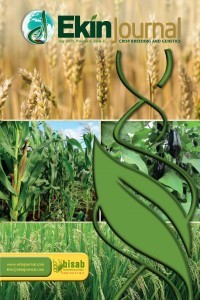Genetic Studies on Triticum timopheevi Based Cytoplasmic Genetic Male Sterility (CGMS) System in Relation to Hybrid Seed Production in Wheat (T. aestivum L.).
Genetic Studies on Triticum timopheevi Based Cytoplasmic Genetic Male Sterility (CGMS) System in Relation to Hybrid Seed Production in Wheat (T. aestivum L.).
Forty-five F1 hybrids were produced by crossing fifteen elite wheat cultivars used as pollen donor/ male parents with three T. timopheevi based male sterile lines used as female parents. Self-fertility status of these F1 hybrids was studied. Two indexes, viz., number and percentage of seed development in bagged spikes of these forty-five F1 hybrids, bagged before starting of anthesis, were used to determine the degree of fertility restored in the F1 hybrids. Based upon a scale devised using the second index, i.e. percentage of seed development in bagged spikes, corresponding pollen parents were identified and classified as maintainer, partial maintainer, partial restorer or restorer. In the present study, WH 542 and KRL 99 were identified as partial restorers for CMS line WH 416A. Agronomic performances of the forty-five hybrids produced were also studied for days to heading, plant height, number of tillers per plant, number of florets per spike. F1 cross-combinations, WH 416A X CBW 38, WH 416A X DBW 39, WH 416A X DBW 50 and WH 416A X NIAW 1188 were found remarkable for their agronomic performance.
___
- Adugna A., Nanda G. S., Singh K., Bains N. S., (2004). A comparison of cytoplasmic and chemically- induced male sterility systems for hybrid seed production in wheat (Triticum aestivum L.). Euphytica, 135: 297-304.
- Arya R. K., Kanboj M. C., Kumar S., (2015). Performance of medium maturing hybrids under Haryana agro-climatic conditions. Forage Res. 41: 130-134.
- Arya R. K., Sethi S. K., (2005). Studies on floral traits influencing out crossing in wheat (Triticum aestivum L.). Natnl. J. Pl. Improv. 7: 73-76.
- Blouet A., Streiff K., Guckert A., (1999). Possibilities for hybrid seed production in wheat. In: A.S. Basra (Ed.), Heterosis and Hybrid Seed Production in Agronomic Crops, pp. 81-117. The Haworth Press Inc., U.S.A.
- Chase C. D., (2006). Cytoplasmic male sterility: a window to the world of plant mitochondrial- nuclear interactions. Trends in Genetics. 23: 81-90.
- Ikeguchi S. A., Hasegawa T., Murai & Tsunewaki K., (1999). Basic studies on hybrid wheat breeding using the IBL-IRS translocation chromosome of Aegilops kotschyi cytoplasm system: Development of male sterile and maintainer lines with discovery of a new fertility - restorer. Euphytica, 109: 33-42.
- Kant S., Lamba R. A. S., Arya R. K., Pawar I. S., (2014). Effect of terminal heat stress on stability of yield and quality parameters in bread wheat in South-West Haryana. Journal of Wheat Research 6: 64-73.
- Kihara H., (1951). Substitution of nucleus and its effect on genome manifestations. Cytologia 16: 177-193.
- Kumar A., Yadav I. S., Arya R. K., (2013). Combining ability and heterosis for some yield traits and protein content in pearl millet. Forage Res. 39: 105-113.
- Linke B., Borner T., (2005). Mitochondrial effects on flower and pollen development. Mitochondrion, 5: 389-402
- Mukai Y., Tsunewaki K., (1979). Basic studies on hybrid breeding: A new male sterility -fertility restoration system in common wheat utilizing cytoplasms of Aegilops kotschyi and Ae. miriabilis. Theoretical and Applied Genetics 54: 153-160.
- Sage G. C. M., (1976). Nucleo-cytoplasmic relationship in wheat, Advances in Agronomy 28: 265-298.
- Singh S. K., P. K. Bhati, A. Sharma and V. Sahu, (2015). Super hybrid rice in China and India: Current status and future prospects. Int. J. Agric. Biol., 17: 221-232.
- Tsunewaki K., Wang G., Matsuoka Y., (2002). Pasmon analysis of Triticum and Aegilops. 2. Characterization and classification of 47 plasmons based on their effect on common wheat phenotype. Genes and Genetic Systems 77: 409-427.
- Wilson J. A., Ross W. M., (1962). Male sterility interaction of the Triticum aestivum nucleus and the Triticum timopheevi cytoplasm. Wheat Information service, 14: 2-9.
- Zhao F. W., (1988). Characteristics of new CMS lines. Proceedings of 7th International Wheat Genetics Symposium, pp. 687-691.
- ISSN: 2149-1275
- Yayın Aralığı: Yılda 2 Sayı
- Başlangıç: 2015
- Yayıncı: Bitki Islahçıları Alt Birliği
Sayıdaki Diğer Makaleler
Halit KARAGOZ, Umran KUCUKOZDEMIR, Berrin DUMLU, Zeki YALCIN
Meteroglyph Analysis of Cowpea (Vigna unguiculata L.Walp) Elite Genotypes
Rajesh Kumar ARYA, Ravish PANCHTA, Nguyen Nagoc VU, Surender Kumar PAHUJA
Tea (Camellia sinensis) Cultivation and Breeding in Turkey: Past and Present Status
Fatih SEYIS, Emine YURTERI, Aysel OZCAN
Sudhir Kumar SETHI, Krishnendu GUIN, Rajesh Kumar ARYA
Performance of Wheat Genotypes for Grain Yield and its Attributes under Irrigation with Saline Water
Rishi Kumar BEHL, Babita KHOSLA, Pravin Kumar SHARMA, Mohammad AHATSHAM, Vikash VIKASH, Pratima PRATIMA, Vijay DAHIYA, Om Prakash BISHNOI
Recent Developments in Triticale Breeding Research and Production - An Overview
